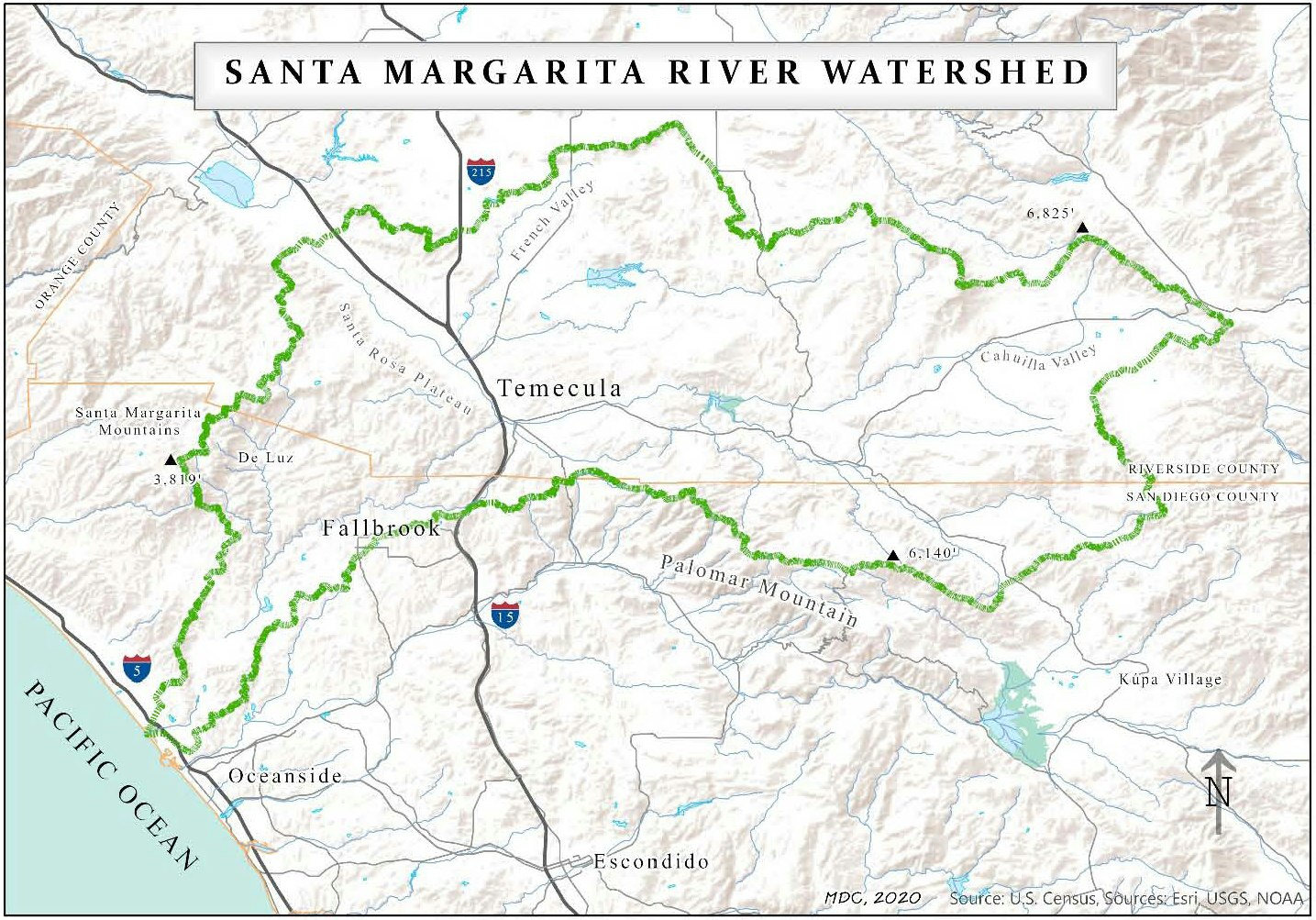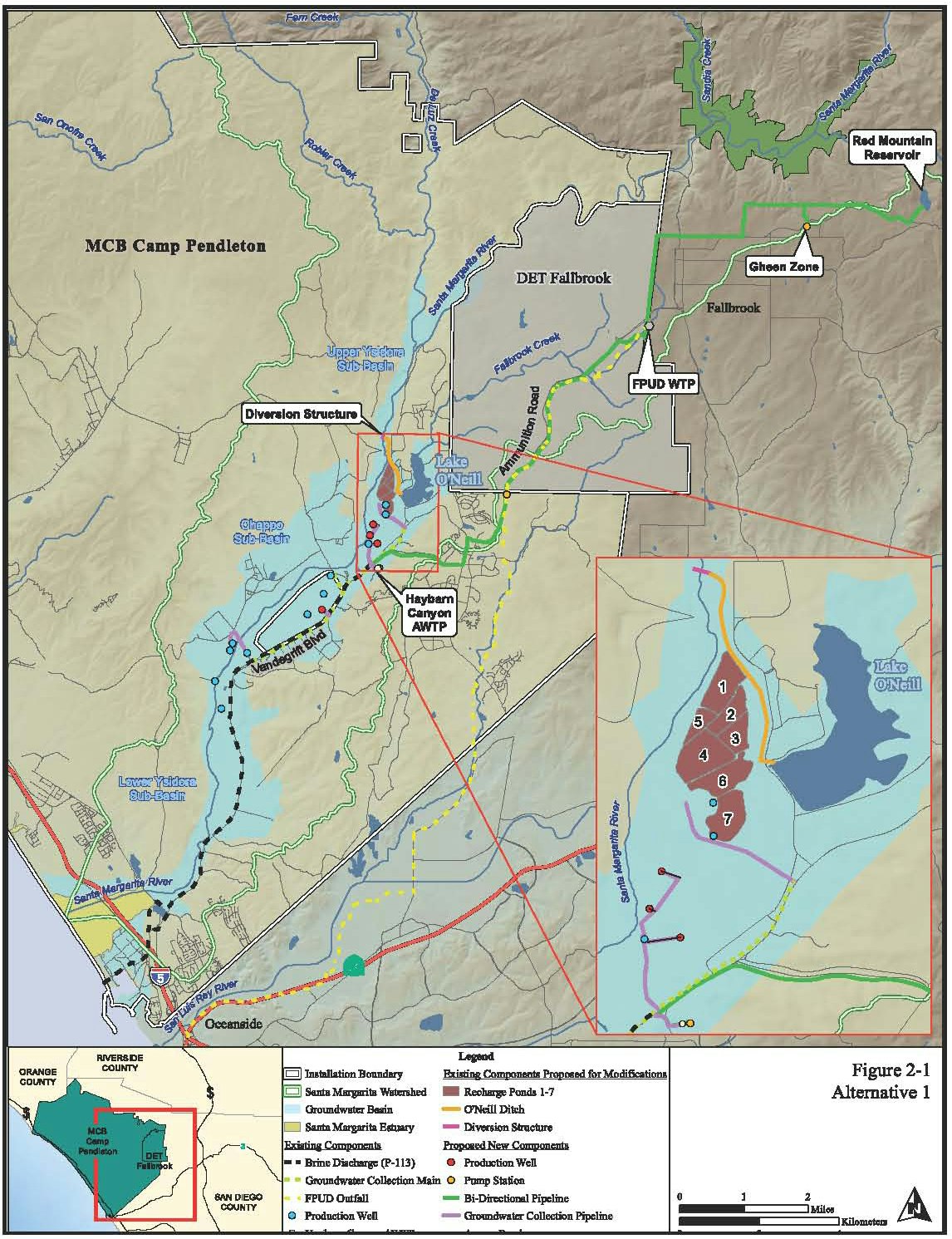Santa Margarita Conjunctive Use Project FAQ
Frequently Asked Questions
Where is the Santa Margarita River watershed located?
The Santa Margarita River watershed runs from Cahuilla Valley and the northern slopes of Palomar Mountain as Temecula Creek, French Valley and northeastern escarpment of the Santa Rosa Plateau as Murrieta Creek, and the Santa Rosa Plateau and Santa Margarita Mountains as De Luz and Sandia Creeks. The river passes through Riverside and San Diego counties, and the communities of Temecula and Fallbrook before it empties into the Pacific Ocean just north of Oceanside (see map below).

Who has access to take water from the watershed?
Many local water users have rights to draw from the watershed including private well owners, public utilities, Native American groups and the United States military. Tracking water use in the watershed is a complicated task which is managed by a federally appointed official known as a Watermaster. The Watermaster produces annual reports that are available for public review.
Is water going to be taken directly from the river?
No, the Santa Margarita River Conjunctive Use Project (SMRCUP) will bring water to Fallbrook through existing wells currently in operation on Camp Pendleton (“conjunctive use”). These wells draw water from an underwater aquifer that is fed by the Santa Margarita River.
How has Camp Pendleton been involved in this project?
Camp Pendleton owns and operates the wells and pumping facilities that draw water from the watershed and has constructed the pipeline to deliver water to the District.
Why is this water source only now being developed?
The Fallbrook Public Utility District (District) has held water rights to the Santa Margarita River going back nearly a century, but longstanding legal challenges have kept the District from developing those rights. In addition, during the 1960s plans were made to build a dam and a reservoir on the river north of Fallbrook, but the project met an impasse during environmental review. Legal and environmental review and construction planning for the successful project has taken many years and considerable financial investment. To cover a substantial portion of planning and environmental review costs, the District was able to secure $2.5 million in grant funding from the California Department of Water Resources (DWR).
How much water will the District receive from this project?
The minimum amount of water that is anticipated from the project is 3,100 acre feet per year (more than 1 billion gallons), or roughly 30% of the District’s water demand, but based on current demand on base it is expected that project will deliver on average about 5,000 AFY or more than half of the District’s water demands. An acre foot equals 325,851 gallons.
Do FPUD ratepayers have to pay a wholesale water agency for the SMRCUP water we receive?
No, water from the SMRCUP is a local water source, independent of charges that the Metropolitan Water District (MWD) levy to import water from the Colorado River (Bureau of Reclamation) and the Sacramento Bay Delta (State Water Project).
How will this new source of water affect water rates?
The cost of the water from the project is projected to be less than the cost of the imported water we buy and it is anticpated to escalate at a lower rate. In recent years imported water rates have increased approximately 6%-8% per year. Additionally, the District’s cost share for infrastructure projects built by the San Diego County Water Authority (SDCWA) will decrease, as the District’s proportional share of these expensive projects is based upon how much imported water is purchased. As a result, the primary goal of the SMRCUP is to reduce long-term water costs.
How will water get from wells on Camp Pendleton to Fallbrook?
Water drawn from well facilities will be pumped approximately four miles and four hundred vertical feet to a water treatment plant (WTP) on District land on Alturas Rd near the entrance to the Naval Weapons Station on Ammunition Rd (see diagram below).

What are the costs of SMRCUP and how is the District paying for them?
The biggest cost associated with the project is the construction of a water treatment plant (WTP) to treat raw water from the watershed prior to delivery to FPUD customers. Additional pipeline and tank facilities will be installed throughout the District to incorporate SMRCUP water into the existing District infrastructure grid. Construction of the WTP and other SMRCUP facilities is currently underway, with a scheduled completion in 2021, and a projected cost of $55-$60 million. The District is funding the construction phase of the SMRCUP with a loan from the State Revolving Fund, which will be repaid over 20 years. The District also received a rebate from the Metropolitan Water District to support local supply development that will pay us over $300/AF for water we produce from the project. In addition, District staff prepared a grant proposal for $2.5 million to fund some of the advanced treatment facilities and this proposal is currently being reviewed by DWR (Proposition 68). Once the WTP is operational and the SMRCUP produces water, the District will have costs for water pumping from Camp Pendleton and operations and maintenance costs associated with running a WTP.
Is water from the Santa Margarita River safe to drink?
Once water from the Santa Margarita River Watershed has gone through treatment facilities it will be a very safe, local source of water. Specific treatment facilities at the WTP include iron and manganese removal, and reverse osmosis (RO) filtration to remove total dissolved solids (primarily salts). Recent concerns about PFAS (per- and polyfluoroalkyl substances), a contaminant of concern (COC), have drawn significant attention from a broad array of stakeholders, including: consumers; public health professionals; federal, state and local regulators, elected officials and the media. As a result, the District has added additional granular activated carbon (GAC, colloquially referred as charcoal filtration) advanced treatment facilities to the original designs of the WTP. RO and GAC facilities will provide the most effective available method of treatment to remove PFAS and other potential future contaminents. The SMRCUP WTP will effectively remove trace amount of contaminants and provide a safe, local source of water.
Are environmental planning documents available for the public to review?
Yes, the Environmental Impact Report (EIR) for the SMRCUP is available for public review on our website at www.fpud.com/governing-our-district. It was adopted in May 2015 by the District’s Board after extensive outreach and public review. Also available in this section of our website are detailed records of Board of Director meetings (materials and minutes), financial records, compensation schedules, planning and operation documents, written transcripts of public meetings and other detailed records.
Can I contact the District for more information on the SMRCUP or other projects?
If you have any further questions about District projects, or if you would like to speak to District staff directly, please feel free to call us at (760) 728-1125, or send us a message through our website (click the “Contact Us” button at the bottom the page.)
